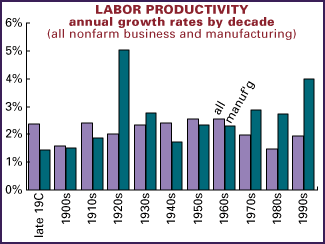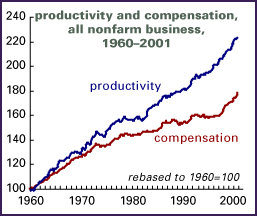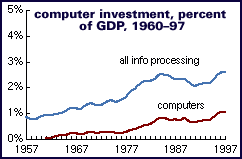Home
Mail Articles
Stats/current
Supplements
Subscriptions
Links
The following article appeared in Left Business Observer
#79, October 1997. It retains its copyright and may not be reprinted or
redistributed in any form - print, electronic, facsimile, anything - without
the permission of LBO.
Where's the payoff?
Daniel E. Sichel, The Computer Revolution: An Economic Perspective (Washington:
Brookings Institution Press, 164 pp., $38.95 hardcover, $16.95 paperback).
Adherents of the New Paradigm - a fashionable doctrine holding that new
technology has kicked the U.S. economy onto a permanently higher productivity
path, meaning perpetual growth without inflation, and, most importantly,
an exuberant, eternal bull market in stocks - took cheer from revisions
to the second quarter productivity figures. Instead of rising a mere 0.7%
annual rate, as the Bureau of Labor Statistics initially reported, output
per hour worked blossomed this past spring by 2.7%. Finally, heavy investments
in computers and other electronic gadgetry were showing up in the productivity
numbers, where they'd been MIA for years.
Or, putting the emphasis somewhat differently, as Business Week observed,
"[T]he new industrial revolution [computers] herald has hardly begun.
Their real potential has been snagged in false starts in use - but they're
on their way." Finally! And, computers might also put an end to the
business cycle. The only problem with these arguments is that they come
from the magazine's June 21, 1958, issue.
That BW quote is marshalled by Daniel Sichel, along with quite a few
others from the business press over the last 40 years, to show that the
payoff lurking just around the corner - or finally arriving - is an ancient
theme in popular commentary on the economic possibilities of computers.
Yet despite the latest BLS revision of the productivity figures , the long-term payoff still seems deferred; the spring 1997 burst looks
like a blip if you inspect any time period longer than three months. The
present business cycle expansion, now over six years old, has the lowest
rate of productivity growth of any since modern numbers begin in 1947, and
the 1990s are the weakest decade of the five shown in the nearby chart.
Yes, there's a pickup in manufacturing productivity compared with earlier
decades, but this is almost certainly the result of closing weaker plants
rather than upgrading existing ones, and of contracting out for services
like janitoring and accounting, meaning that these low-productivity functions
are no longer pulling down the manufacturing numbers. Computers were supposed
to bring a productivity blessing to the service industries, but with rare
exceptions, they're not.
, the long-term payoff still seems deferred; the spring 1997 burst looks
like a blip if you inspect any time period longer than three months. The
present business cycle expansion, now over six years old, has the lowest
rate of productivity growth of any since modern numbers begin in 1947, and
the 1990s are the weakest decade of the five shown in the nearby chart.
Yes, there's a pickup in manufacturing productivity compared with earlier
decades, but this is almost certainly the result of closing weaker plants
rather than upgrading existing ones, and of contracting out for services
like janitoring and accounting, meaning that these low-productivity functions
are no longer pulling down the manufacturing numbers. Computers were supposed
to bring a productivity blessing to the service industries, but with rare
exceptions, they're not.
Why not? Sichel's little book gives lots of good answers.
Why it matters
Before reviewing Sichel's arguments, it might be worth recalling just
why productivity is important at all. Leaving aside all qualitative questions
for the moment, how much workers can produce in an hour of labor is the
fundamental determinant of the level of material wealth. Or, more precisely,
it marks a limit on the level of a society's material welfare; many other
things, like politics and social institutions, determine how the produce
of an hour's labor is divided. It can go into wages, social welfare  spending, salaries paid to bosses, or interest and dividends paid to
rentiers. Over the last 20 years in the U.S., wages have grown even more
slowly than productivity, which is another way of looking at the polarization
of incomes: money has been trickling upwards, thanks to higher managerial
salaries and growing financial claims, because workers have been getting
a smaller share of what they produce. But there's no question that the productivity
slowdown has also contributed to wage stagnation. So were computers capable
of the productivity miracles attributed to them, there's a chance that average
incomes could rise again without making lots of institutional changes (like
unionization and an attack on the rentiers).
spending, salaries paid to bosses, or interest and dividends paid to
rentiers. Over the last 20 years in the U.S., wages have grown even more
slowly than productivity, which is another way of looking at the polarization
of incomes: money has been trickling upwards, thanks to higher managerial
salaries and growing financial claims, because workers have been getting
a smaller share of what they produce. But there's no question that the productivity
slowdown has also contributed to wage stagnation. So were computers capable
of the productivity miracles attributed to them, there's a chance that average
incomes could rise again without making lots of institutional changes (like
unionization and an attack on the rentiers).
On first, and even second, glance, it might seem that computers could
contribute mightily to productivity, especially since the price of computing
power has been dropping like a stone for decades. The Department of Commerce's
official price measure, the price index that goes into the GDP accounts,
has fallen an average of 16% a year since figures began in 1965 - and persistently.
The decline was actually steeper in the 1960s and 1970s than it was in the
1980s or so far in the 1990s.
But to focus on that price decline alone is to miss many significant
points, as Sichel shows. It says nothing about the costs of software, training,
repairs, or support, which are declining much more slowly if at all. And
their levels can be quite high; private consultants estimate, for example,
that a $2,500 PC costs a typical big business from $6,000 to $13,000 a year
in such secondary expenditures. Miracles can easily disappear in overhead
like that.
And the hardware price decline is itself a financial pitfall: it means
that an investment made today depreciates very rapidly. Though a 1992 computer
may still "work" in the literal sense, it probably can't run 1997's
best software. For an existing business, computers that come in the front
door are often replacements for ones going out the back door. That pace
of obsolescence can be very expensive, a fact that barely penetrates the
cybertopians' prose.
Growth models
Another reason that the computer payoff is so elusive is that they account
for a surprisingly small share of both current spending and the total stock
of capital equipment.  For the first half of 1997, just a hair
over 1% of GDP was devoted to business investment in computers; in 1996,
they accounted for only 2% of the value of all capital equipment (a very
dicey thing to estimate, it must be conceded). And, also surprisingly, these
numbers have only risen slightly since the early 1980s.
For the first half of 1997, just a hair
over 1% of GDP was devoted to business investment in computers; in 1996,
they accounted for only 2% of the value of all capital equipment (a very
dicey thing to estimate, it must be conceded). And, also surprisingly, these
numbers have only risen slightly since the early 1980s.
If money spent on computers is such a small portion of the economy, it
makes sense that their contribution to overall productivity and growth can't
be all that large. Sichel takes that intuition and mathematizes it, using
orthodox neoclassical growth models. In these models, economic growth is
the combined result of new capital investments plus the increase in work
effort (more workers and/or longer hours). Higher investments should mean
higher profits, and more work should mean more wages - together these yield
a higher GDP. Such models have their limits - for one, the intense difficulty
of measuring the monetary value of capital equipment, especially something
as rapidly changing and prone to obsolescence as computers, not to mention
their indifference to intangibles like education, attitudes, and social
institutions - but they're a good place to start.
In this instance, let's assume that computers earn a "normal"
rate of profit - the average rate of return on capital of all kinds throughout
the entire U.S. economy. Since those profits count as part of GDP, computers'
contribution to economic growth would equal the profits earned on new computer
investments as a share of growth through the entire economy. (More complications:
estimating a "normal" rate of profit, and then assuming that these
profits come from the machinery rather than the workers who operate them
- but again we're leaving these aside for the sake of argument.) From this,
Sichel estimates that computers contributed just 5% to total U.S. economic
growth between 1970 and 1992. Other forms of capital investment contributed
nearly seven times as much. Worse, notes Sichel, "as firms boosted
their purchases of computers [since 1980], they scaled back investments
in other capital." Adding in software and computer-related services
boosts the growth contribution a bit, but not by much. Even if you assume
that computers yield superprofits, above the "normal" rate (as
some studies have claimed), their overall contribution would still be minimal,
given their small share of the overall capital stock. But if they were yielding
such big returns, it's a safe bet that firms would be investing a lot more
in computers than they are.
The long view
OK, so maybe we're just being impatient by expecting the productivity
payoff to arrive so soon. This is the view of Stanford University economist
Paul
David, who claims that it took several decades for the productivity
advance offered by the electric motor to kick in (an analysis endorsed by
Alan Greenspan). But computers are hardly new arrivals anymore.
Though their ancestors go back into the 19th century, what is usually called
the first real computer, the Manchester University Enhanced Mark I, was
built in 1949, and the basics of modern computer architecture were established
by the 1960s. Obviously they've gotten much faster and slicker over the
last 50 years, but they've been a fact of life for quite a long time now.
More broadly, as James Beniger shows in his book The Control Revolution,
the management of "information" has been playing an increasingly
important role for over 150 years, as capitalist industrialization has jacked
up the speed and scope of economic life. Past technological advances increased
the ability to collect and distribute information in ways we may find old
hat today, but were eye-popping in their own time. Typewriters, printing
presses, adding machines, punched-card tabulators, and the telegraph all
increased the speed of information processing in their day by factors comparable
to what computers have done since 1949. And, Sichel shows, none of this
seemed to increase the rate of growth; you could read Beniger as arguing
that the purpose of info tech has been to cope with the blooming, buzzing
confusion of industrial life, managing growth rather than accelerating it.
Of course, just because computers haven't yielded a great productivity
payoff doesn't mean that they're not changing the way we live and work.
To take one very dear example, this newsletter could not exist in its present
form - produced by a full-time equivalent staff of less than two, with up-to-date
stats and reasonably presentable graphics - in a pre-microcomputer world.
Nor would our music be so heavily sampled, nor public and private databases
so full of information on all of us, nor new financial instruments be invented
or traded with such vigor. But these sorts of qualitative issues are generally
beyond the ken of most economists.
Nor does Sichel's sort of analysis say anything about the political possibilities
of using computers in liberating ways - to reduce the burden of tedious
work (though computers have certainly created their share of tedious work
too), or rehabilitating unfashionable ideas about worker self-management
and broader economic planning. On that latter point, conservative critiques
of planning frequently center on the inability of planners to get their
heads around the vast quantity of information in a complex economy. That
may have been true in the past, but it's harder to accept in the time of
Deep Blue.
Computers don't deliver the quantitative productivity boost they're alleged
to, but that may be the wrong thing to ask of them.
SIDEBAR: Myths of origin
While we're fact-checking some of the mythology that's grown up around
computers, it's worth recalling the message of an older Brookings book,
Kenneth
Flamm's historical overview, Creating the Computer. In the received
version of this history, equally popular on Wall Street and in the Silicon
Valley, the machines were developed by plucky entrepreneurs tapping our
wondrously munificent and flexible capital markets. While there's no denying
the role of upstarts and venture capitalists in the evolution of the computer,
especially over the last couple of decades, it's hard to imagine the machines
would exist in their present form without several decades of support from
the U.S. government, especially the military.
It's hard to overstate the government's role in the first few decades
of the computer era, and even before. Ancestors like radar and code-breaking
machinery were developed under government contracts as early as the First
World War, and the Second accelerated the effort. Even such modern-seeming
gadgets as video terminals, the light pen, the drawing tablet, and the mouse
evolved from Pentagon-sponsored research in the 1950s, 1960s, and 1970s.
And the Internet, today celebrated as proof of the superiority of American
capitalism, owes its very existence to the Pentagon's interest in having
a communications network that could survive a nuclear war. The military's
influence on software was less pervasive - though no one would have even
developed a programming language without a machine to run it on. But even
here, Washington's generous hand is visible: database software has its roots
in Air Force and Atomic Energy Commission projects, artificial intelligence
in military contacts going back to the 1950s, and airline reservation systems
in 1950s air-defense systems. More than half of IBM's R&D budget came
from government contracts in the 1950s and 1960s, and IBM's corporate ancestor
got its start providing punched-card technology for the 1890 Census.
Point these facts out to the libertarians who populate the Internet,
and they often respond by saying it all would have happened anyway. But,
as Flamm writes, "Key players in the military first tried to convince
established businesses and investment bankers that a new and potentially
profitable business opportunity was presenting itself. They did not succeed,
and, consequently, the Defense Department committed itself to financing
an enormously expensive development program...." Europe's weakness
in computers is often attributed to its stodgy business culture and thin
financial markets, but, as Flamm shows, European governments were too stingy
in their subsidies in the 1950s to get an industry going. By the 1960s,
the U.S. lead was unbeatable.
Home Mail
Articles Stats/current
Supplements
Subscriptions
Links
 , the long-term payoff still seems deferred; the spring 1997 burst looks
like a blip if you inspect any time period longer than three months. The
present business cycle expansion, now over six years old, has the lowest
rate of productivity growth of any since modern numbers begin in 1947, and
the 1990s are the weakest decade of the five shown in the nearby chart.
Yes, there's a pickup in manufacturing productivity compared with earlier
decades, but this is almost certainly the result of closing weaker plants
rather than upgrading existing ones, and of contracting out for services
like janitoring and accounting, meaning that these low-productivity functions
are no longer pulling down the manufacturing numbers. Computers were supposed
to bring a productivity blessing to the service industries, but with rare
exceptions, they're not.
, the long-term payoff still seems deferred; the spring 1997 burst looks
like a blip if you inspect any time period longer than three months. The
present business cycle expansion, now over six years old, has the lowest
rate of productivity growth of any since modern numbers begin in 1947, and
the 1990s are the weakest decade of the five shown in the nearby chart.
Yes, there's a pickup in manufacturing productivity compared with earlier
decades, but this is almost certainly the result of closing weaker plants
rather than upgrading existing ones, and of contracting out for services
like janitoring and accounting, meaning that these low-productivity functions
are no longer pulling down the manufacturing numbers. Computers were supposed
to bring a productivity blessing to the service industries, but with rare
exceptions, they're not. spending,
spending,  For the first half of 1997, just a hair
over 1% of GDP was devoted to business investment in computers; in 1996,
they accounted for only 2% of the value of all capital equipment (a very
dicey thing to estimate, it must be conceded). And, also surprisingly, these
numbers have only risen slightly since the early 1980s.
For the first half of 1997, just a hair
over 1% of GDP was devoted to business investment in computers; in 1996,
they accounted for only 2% of the value of all capital equipment (a very
dicey thing to estimate, it must be conceded). And, also surprisingly, these
numbers have only risen slightly since the early 1980s.